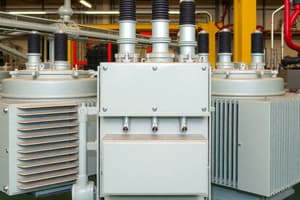Podcast
Questions and Answers
What is the effect of using a divertor across a series field?
What is the effect of using a divertor across a series field?
- Adjusts the degree of compounding (correct)
- Decreases efficiency
- Reduces power factor
- Increases output voltage
What does the term 'inductively and conductively' refer to in energy transfer?
What does the term 'inductively and conductively' refer to in energy transfer?
- Only inductive energy transfer
- A combination of inductive and conductive methods (correct)
- Only conductive energy transfer
- Energy transfer loss
In what scenario is the percentage carrier power increased?
In what scenario is the percentage carrier power increased?
- When the amplitude of the carrier is increased (correct)
- When voltage transformation ratio is low
- When the phase angle is minimized
- When the signal amplitude decreases
What is a function of a 'synchronous motor'?
What is a function of a 'synchronous motor'?
What is the purpose of mechanical braking?
What is the purpose of mechanical braking?
What is the primary characteristic of a synchronous motor?
What is the primary characteristic of a synchronous motor?
What type of motor would be unsuitable for heavy duty starting?
What type of motor would be unsuitable for heavy duty starting?
Which motor type is typically associated with high starting torque?
Which motor type is typically associated with high starting torque?
What is the primary function of commutator bars in a motor?
What is the primary function of commutator bars in a motor?
What voltage type do silicon diodes primarily operate with?
What voltage type do silicon diodes primarily operate with?
What is the primary role of inductance in electrical circuits?
What is the primary role of inductance in electrical circuits?
What typically causes sparking in electrical motors?
What typically causes sparking in electrical motors?
Which motor type is efficient for use in lifts and hoists?
Which motor type is efficient for use in lifts and hoists?
Flashcards
Synchronous Motor
Synchronous Motor
An electrical machine that operates at constant speed regardless of load.
Slip Ring Induction Motor
Slip Ring Induction Motor
An induction motor which uses slip rings for rotor connection, allowing variable speed.
Commutator Bars
Commutator Bars
Conductive metal bars in a DC motor that switch current direction in the rotor.
Transformers Loss
Transformers Loss
Signup and view all the flashcards
DC Motor
DC Motor
Signup and view all the flashcards
High Starting Torque
High Starting Torque
Signup and view all the flashcards
Armature Current
Armature Current
Signup and view all the flashcards
Inductive Impedance
Inductive Impedance
Signup and view all the flashcards
Voltage Transformation Ratio
Voltage Transformation Ratio
Signup and view all the flashcards
Inductive and Conductive Energy Transfer
Inductive and Conductive Energy Transfer
Signup and view all the flashcards
Carrier Amplitude Change
Carrier Amplitude Change
Signup and view all the flashcards
Fixed Loss
Fixed Loss
Signup and view all the flashcards
Safety Valve Function
Safety Valve Function
Signup and view all the flashcards
Study Notes
Electrical Engineering Review
- Transformer Losses: Total transformer loss depends on volt-ampere.
- Commutator Bars: A closed commutator has twice the commutator bars per pole.
- Full-Pitch Winding: A full-pitch winding has twice the commutator bars.
- Induced EMF Addition: Ensure the addition of induced electromotive forces (EMFs) of consecutive turns.
- AC to DC Conversion: Methods convert alternating current (AC) to direct current (DC).
- Waveform Characteristics: High and low waveforms.
- Load Dependent: Magnitude of the load and load flux determine the pole flux.
- Pole Flux and Load: The load flux in a synchronous motor establishes a constant pole flux.
- Armature Current: Armature current in DC machines is clockwise.
- Cross-magnetizing Flux: Neutralizing cross-magnetizing flux.
- Various Configurations: 270° field configuration of several types.
- Building a Structure: Structures can be built using certain physical properties.
- Electrical System Properties: Series, parallel, and other configurations.
- Compounding in Generators: Negative degree of compounding in generators.
- Compensating for Losses: Methods to compensate for losses in power systems.
- Copper Losses & Iron Losses: Copper loss is high compared to iron loss in a system.
- Transformer Core Loss: Core loss in transformers.
Types of Motors
- Squirrel Cage Induction Motor: Squirrel cage induction motor.
- Slip Ring Induction Motor: Slip ring induction motor.
- Synchronous Motor: Synchronous motor.
- Schrage Motor: Schrage motor type.
- Ceiling Fan Motor: Ceiling fan motor.
- High Power Factor Motors: High power factor motors.
- Silicon Diode Application: Silicon diode application in motors.
- Synchronous Motor: Also a type of synchronous motor.
- DC Motors: Different types of DC motors.
- AC Slip Ring Motor: An AC slip ring motor.
Motor Characteristics
- Starting Torque: High starting torque in AC slip ring motors.
- Motor Types: AC slip ring motors, repulsion motors, and their duties.
- Loading Conditions: Totally enclosed fan cooled, operating under various conditions and loads.
- Motor Types Continued: permanent magnet type motors and other common configurations.
- AC Motors (various): different properties of AC motors.
- Applications (General Motors): Applications for various motor types.
Electrical Concepts and Properties
- Alternating Current (AC): Various characteristics of AC current and systems.
- Direct Current (DC): Various characteristics of DC current and systems.
- Amplitudes and Modulation: Relationship between amplitude, modulation and related properties.
- Frequency and Signal Translation: Translate low frequency information through different means and processes.
Additional Concepts
- Impedance and Impedance Matching: Impedance matching and other important factors.
- Carrier Power: Percentage carrier power is increased.
Studying That Suits You
Use AI to generate personalized quizzes and flashcards to suit your learning preferences.




